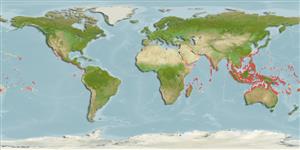Common names from other countries
>
Eupercaria/misc (Various families in series Eupercaria) >
Haemulidae (Grunts) > Plectorhinchinae
Etymology: Plectorhinchus: Greek, plektos = plaited + Greek, rhyngchos = snout (Ref. 45335).
More on author: Lacepède.
Environment: milieu / climate zone / depth range / distribution range
Écologie
marin; eau douce; saumâtre récifal; profondeur 8 - 25 m (Ref. 58652). Tropical; 30°N - 24°S
Indo-West Pacific: Red Sea to Natal, South Africa (including Madagascar and the Comoro and Reunion islands); Gulf of Aden and the Persian Gulf eastward to Samoa, north to the Ryukyu Islands, south to Australia; Caroline and Mariana islands in Micronesia.
Taille / Poids / Âge
Maturity: Lm ? range ? - ? cm
Max length : 75.0 cm TL mâle / non sexé; (Ref. 30874)
Épines dorsales (Total): 14; Rayons mous dorsaux (Total): 15-16; Épines anales 3; Rayons mous anaux: 7 - 8.
Found in coastal reefs, sandbanks, and near estuaries (Ref. 30573). Enter freshwater (Ref. 7050). Small juveniles occur along sheltered sandy shorelines where they mimic a dead leaf by drifting on their sides (Ref. 37816). Adults mainly in protected inshore reefs to deep offshore, sometimes swims in small groups (Ref. 48635). Excellent food fish (Ref. 2799).
Life cycle and mating behavior
Maturité | Reproduction | Frai | Œufs | Fécondité | Larves
Oviparous, distinct pairing during breeding (Ref. 205).
Myers, R.F., 1991. Micronesian reef fishes. Second Ed. Coral Graphics, Barrigada, Guam. 298 p. (Ref. 1602)
Statut dans la liste rouge de l'IUCN (Ref. 130435)
CITES (Ref. 128078)
Not Evaluated
Menace pour l'homme
Reports of ciguatera poisoning (Ref. 2799)
Utilisations par l'homme
Pêcheries: commercial; pêche sportive: oui
Plus d'informations
RéférencesAquacultureProfil d'aquacultureSouchesGénétiqueElectrophoresesHéritabilitéPathologiesTraitementMass conversion
CollaborateursImagesStamps, Coins Misc.SonsCiguateraVitesseType de nageSurface branchialeOtolithesCerveauxVision
Outils
Articles particuliers
Télécharger en XML
Sources Internet
Estimates based on models
Preferred temperature (Ref.
115969): 25.2 - 29.3, mean 28.4 (based on 3703 cells).
Phylogenetic diversity index (Ref.
82804): PD
50 = 0.5000 [Uniqueness, from 0.5 = low to 2.0 = high].
Bayesian length-weight: a=0.01995 (0.01110 - 0.03588), b=2.93 (2.77 - 3.09), in cm Total Length, based on LWR estimates for this species & (Sub)family-body (Ref.
93245).
Niveau trophique (Ref.
69278): 3.6 ±0.5 se; based on diet studies.
Résilience (Ref.
120179): Milieu, temps minimum de doublement de population : 1,4 à 4,4 années (K=0.20).
Fishing Vulnerability (Ref.
59153): Moderate to high vulnerability (45 of 100).
